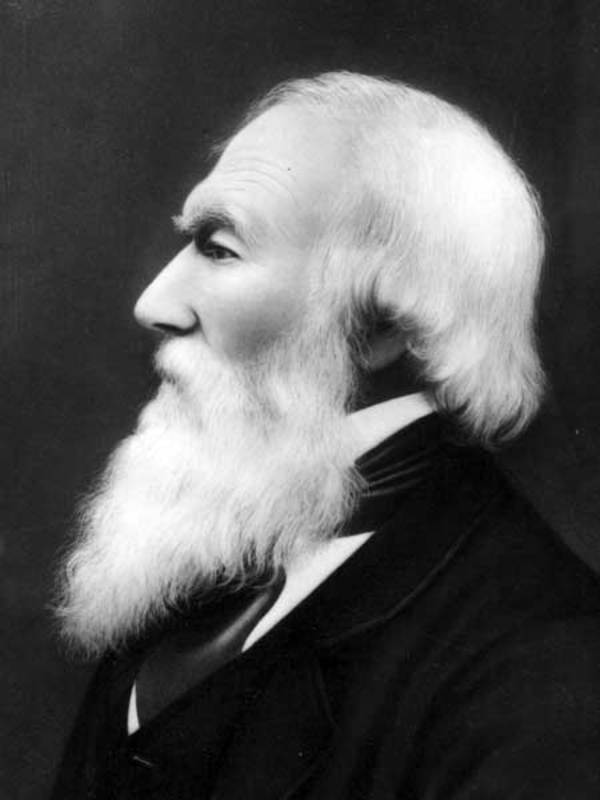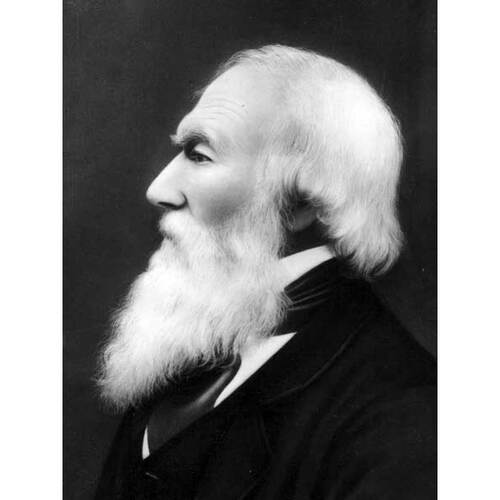
Source: Link
GUNN, DONALD, educator, scientist, historian, and politician; b. at Halkirk, Caithness-shire, Scotland, September 1797, youngest son of William Gunn, a tenant farmer in the strath of Braeholme; d. at St Andrews, Man., 30 Nov. 1878.
Donald Gunn was educated in the parish school of Halkirk. In 1813 he entered the service of the Hudson’s Bay Company and spent ten years at York Factory, Severn Fort, and Oxford House successively, earning promotion to lesser postmaster. In 1819 he married Margaret, eldest daughter of James Swain, a company officer; between 1822 and 1849 they had seven sons and two daughters. In 1823, his services not being required after the union of the HBC and the North West Company, he settled at Red River in “Little Britain,” later the parish of St Andrews. His farm prospered and after ten years the assistance of his growing family enabled him to take charge for the next 18 years of the Church Missionary Society’s parish school. He also acted later in his substantial stone house as custodian and librarian of the only public collection of books in Red River.
A critic of the company and a leader of the settlers in the demand for a greater degree of self-government, Gunn was never appointed to the Council of Assiniboia, but he early became a magistrate and president of the Court of Petty Sessions in his district. He served as foreman of the jury at the trial of Pierre-Guillaume Sayer in 1849. In 1870 he was chosen as delegate from St Andrews to the provisional assembly, although he was an advocate of the entry of the northwest into confederation. The Gunns seem to have been on friendly terms with John Christian Schultz* and his wife. Subsequent to the establishment of Manitoba as a province, Gunn was appointed police magistrate, justice of the peace, postmaster, and inspector of fisheries. On 10 March 1871 he was appointed to the Legislative Council of Manitoba and remained a member until its abolition, which he supported, in 1876.
Gunn played an important part not only in public affairs but also in the cultural and intellectual life of Red River. As an outspoken opponent of the HBC and as a leading Presbyterian layman, he was frequently involved in controversy with the authorities of the colony. Nevertheless he retained the respect of the majority and the personal esteem of many. He was a member of the Council of the Institute of Rupert’s Land of 1862. His interest in natural history was reflected in his experiments with new methods of tillage and new strains of wheat and led to his long-standing connection with the Smithsonian Institution, of which he was one of the earliest meteorological correspondents. He earned a tribute from its secretary for the reliability of his observations of the weather and the importance of the objects he contributed in nearly every branch of natural history as well as archaeology and ethnology. In 1866 he made a special exploration for the Smithsonian of the region west of Lake Winnipeg to collect skins and birds’ eggs, “among the latter several previously entirely unknown in museums.”
Gunn disputes with Alexander Ross* the title of father of the history of Canada’s prairie west. As an historian he was primarily concerned to provide for his readers all the available information. At the same time he by no means ignored the historian’s duty of critical evaluation of his sources. An eye-witness of many of the events described in his posthumously published History of Manitoba, he was aware of the danger of “depending for our knowledge of past events on the special pleading of others.” Though his history is essentially a narrative of events he did not avoid problems of interpretation. His sympathies clearly lie with the settlers rather than with the HBC. A staunch Presbyterian and an elder of his Kirk, he was not illiberal in religious outlook, though often critical of the Anglican and Roman Catholic clergy of the colony. His attitude to those he saw as representative of an unjust order, from Lord Selkirk [Douglas*] to Bishop David Anderson*, was tinged with an acerbity by no means characteristic of the relations with others of this genial and humorous man.
Smithsonian Institution, Annual report, 1878 (Washington), 63–64. Donald Gunn, “Indian remains near Red River settlement, Hudson’s bay territory,” Smithsonian Institution, Annual report, 1867 (Washington), 399–100; “Notes of an egging expedition to Shoal lake, west of lake Winnipeg. Made under the direction of the Smithsonian Institution in 1867 . . . ,” Smithsonian Institution, Annual report, 1867 (Washington), 427–32. Donald Gunn and C. R. Tuttle, History of Manitoba from the earliest settlement to 1835 by the late Hon. Donald Gunn, and from the admission of the province into the Dominion by Charles R. Tuttle (Ottawa, 1880). Begg, Hist. of North-West, I, 393ff., 450; II, 35. Morton, Manitoba, a history.
Cite This Article
L. G. Thomas, “GUNN, DONALD,” in Dictionary of Canadian Biography, vol. 10, University of Toronto/Université Laval, 2003–, accessed December 22, 2025, https://www.biographi.ca/en/bio/gunn_donald_10E.html.
The citation above shows the format for footnotes and endnotes according to the Chicago manual of style (16th edition). Information to be used in other citation formats:
| Permalink: | https://www.biographi.ca/en/bio/gunn_donald_10E.html |
| Author of Article: | L. G. Thomas |
| Title of Article: | GUNN, DONALD |
| Publication Name: | Dictionary of Canadian Biography, vol. 10 |
| Publisher: | University of Toronto/Université Laval |
| Year of publication: | 1972 |
| Year of revision: | 1972 |
| Access Date: | December 22, 2025 |



